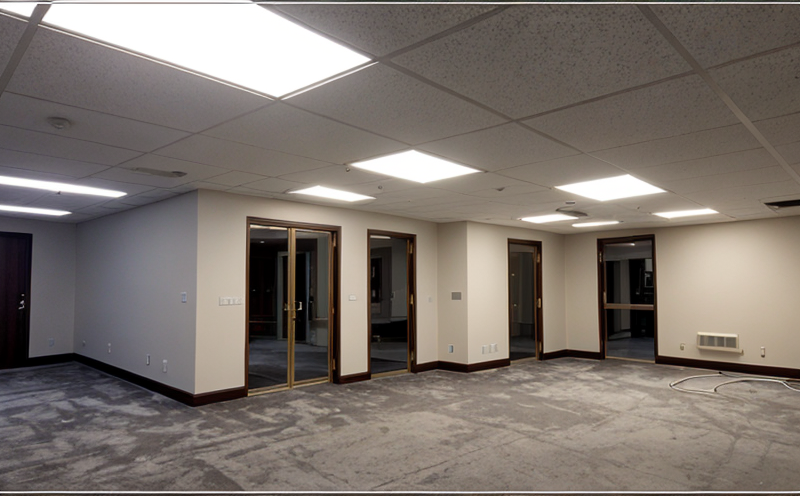ASTM E1477 Reflectance Testing of Architectural Lighting Materials
The ASTM E1477 standard is a critical tool in ensuring that architectural and decorative lighting materials meet specific reflectance performance requirements. This testing methodology is essential for quality managers, compliance officers, R&D engineers, and procurement teams who need to verify the optical properties of these materials before they are used in building projects.
Reflectance refers to the ratio of reflected light to incident light. In architectural lighting, it plays a crucial role in determining how well a material will enhance or alter the ambient light conditions within an environment. For instance, materials with higher reflectance can increase the perceived brightness and comfort in spaces by reflecting more natural light.
The testing procedure outlined in ASTM E1477 involves several steps to ensure accuracy and reliability. The first step is to prepare the specimen according to specified dimensions and orientation. This ensures that any variations in the sample do not affect the test results. After preparation, the specimen is placed into a standard testing chamber equipped with a spectrophotometer.
The spectrophotometer measures the reflectance of the material at various wavelengths across the visible spectrum. The measurements are taken under controlled conditions to ensure consistency and repeatability. ASTM E1477 specifies exact angles and distances between the light source, specimen, and detector to minimize errors due to geometric factors.
The results from the spectrophotometer are then analyzed using statistical methods to determine compliance with specified reflectance performance criteria. This analysis includes calculating the mean value of reflectance across all measured wavelengths and comparing it against a predefined threshold established by project specifications or industry standards.
Understanding why this test is important goes beyond just meeting technical requirements; it also contributes significantly to environmental sustainability efforts. By selecting materials with optimal reflectance, architects can design buildings that are more energy-efficient as they require less artificial lighting during daylight hours.
In summary, ASTM E1477 reflectance testing ensures not only compliance but also optimizes the aesthetic and functional performance of architectural and decorative lighting materials used in various applications. It helps maintain high standards across different sectors, ensuring durability and reliability while contributing positively to sustainable practices.
Quality and Reliability Assurance
Ensuring consistent quality throughout the production process is paramount for any manufacturer of architectural or decorative lighting materials. By implementing ASTM E1477 reflectance testing early in the development stages, companies can identify potential issues before they become costly problems further down the line.
One key aspect of this testing involves regular calibration of instruments to guarantee accurate readings every time. This helps maintain precision and accuracy in measuring reflectance values, which is crucial for meeting both internal quality standards as well as external regulatory requirements.
In addition to instrument calibration, maintaining strict control over environmental conditions during testing enhances reliability by reducing variability in results due to external factors such as temperature fluctuations or humidity levels. Controlling these variables ensures that each measurement reflects true reflectance properties rather than being influenced by environmental variations.
Regular internal audits and third-party certifications also play vital roles in upholding quality standards. Internal audits help identify areas for improvement within the laboratory operations, while third-party certification provides an independent verification of the accuracy and consistency of test results. Both approaches contribute significantly to building trust among clients and stakeholders regarding product integrity.
Implementing robust quality assurance measures based on ASTM E1477 not only improves overall product quality but also fosters innovation by encouraging continuous improvement initiatives aimed at enhancing performance characteristics beyond basic compliance levels. This approach ultimately leads to more competitive products that better meet evolving market demands.
International Acceptance and Recognition
The ASTM E1477 reflectance testing standard enjoys widespread acceptance across numerous countries, making it a widely recognized benchmark for evaluating the optical properties of architectural and decorative lighting materials. Its international relevance stems from its alignment with global standards such as ISO 13663-1:2018 on terminology related to indoor artificial light sources.
Many jurisdictions use ASTM E1477 as part of their regulatory frameworks, ensuring that imported and locally manufactured products adhere to consistent quality benchmarks. This harmonization promotes trade by reducing barriers associated with differing technical requirements between countries.
The use of internationally recognized standards like ASTM E1477 also benefits manufacturers who aim to export their products globally. By adhering to these standards during production processes, they can confidently meet local regulations without having to undergo additional certifications or adjustments for each market.
Moreover, compliance with such widely accepted international standards enhances brand reputation and customer confidence. Consumers and businesses are more likely to choose products that have been rigorously tested according to internationally recognized criteria, knowing that these tests ensure high levels of performance, safety, and reliability.
Environmental and Sustainability Contributions
Incorporating ASTM E1477 reflectance testing into sustainable design practices offers multiple benefits for both the environment and society. One significant advantage lies in reducing energy consumption associated with artificial lighting by optimizing natural daylight usage within buildings.
By selecting materials that enhance natural light reflection, architects can create spaces where occupants experience greater visual comfort while consuming less electricity for indoor illumination needs. This not only reduces operational costs but also contributes positively to environmental conservation efforts aimed at decreasing carbon footprints.
The testing process itself plays an important role in minimizing waste during manufacturing operations through precise measurement techniques that enable accurate material utilization rates. Efficient use of raw materials translates directly into lower resource consumption, which is crucial for fostering sustainable manufacturing practices.
Furthermore, compliance with ASTM E1477 helps promote circular economy principles by facilitating the reuse and recycling of materials within construction projects. When products meet stringent reflectance performance criteria early in their lifecycle, they become more desirable candidates for repurposing or remanufacturing after reaching end-of-life stages.
In conclusion, integrating ASTM E1477 reflectance testing into sustainable design strategies not only enhances building performance but also supports broader environmental goals. By leveraging this standard effectively, stakeholders can contribute meaningfully to creating healthier and more resilient built environments while promoting responsible resource management practices.





